The revolution in Syria in December 2024, which brought to power the Sunni rebels led by Ahmed al-Sharaa, also created a fundamental shift in the regional balance of power. The Iranian-Shiite axis, which enjoyed extensive control in Syria, has been replaced by Sunni forces with heavy representation of Islamist-Jihadist elements.
The vacuum created following the fall of the Assad regime and the withdrawal of its allies, Russia and the Iranian-Shiite axis, from the Syrian arena, was exploited by Sunni Turkey, which quickly became the central player shaping the new Syrian army. Turkey is establishing itself as the main ally of the al-Sharaa regime, while acting to build the strength of its new army through professional training and by supplying weapons and military equipment, so that it can establish its control over the country.
This is a strategic Turkish move to strengthen the Sunni-state alliance in Damascus, designed to project Turkey’s power, the neo-Ottoman and Islamist agenda of Turkish President Erdoğan, and to build a Syrian military capability that can be activated against targets designated by Ankara, including internal targets such as the Kurdish Syrian Democratic Forces (SDF).
Only recently, Turkish Ministry of Defense spokesman, Rear Admiral Zeki Aktürk, commented on the diplomatic process aimed at integrating the SDF into Syrian state institutions. The spokesman stated that Ankara is following the contacts between Damascus and the SDF “very sensitively,” and clarified that Turkey views this organization as an affiliate of the PKK and is therefore closely monitoring any attempt to legitimize it politically or integrate it into the Syrian army.
The question of whether this force will be used against an external rival, with Israel leading the list, remains open.
The process of building Syria’s military force relies heavily on Turkish assistance, which includes professional training, technical support, and the transfer of advanced Turkish-made weaponry.
An important anchor for this cooperation is the security agreement signed between Syria and Turkey in August 2025, which deepens Turkey’s political and security grip on Syria and Syria’s dependence on Ankara. According to the agreement, Turkey will supply Syria with munitions and logistical tools.
From the Israeli perspective, this new reality poses a long-term challenge. Turkish weapons operated by al-Sharaa regime forces could be turned against Israel. The Turkish influence on the Syrian army could lead to independent Syrian use of these weapons against Israel in the future. In addition, the conflict map in Syria has changed fundamentally—the Syrian army is now an asset of an axis rivaling Iran, which also creates opportunities to further weaken that axis.
Turkish Support Channels: Training, Logistics, and Armament
The Turkish assistance to the Syrian army is manifested in many comprehensive aspects, aimed at developing the Syrian army’s fighting capability. The military cooperation agreement, signed between Turkish Defense Minister Yaşar Güler and his Syrian counterpart Murhaf Abu Qasra in August 2025, is intended to develop the Syrian army, strengthen its capabilities, and fully rehabilitate the security system, while training its soldiers according to “international criteria,” according to the official Syrian Arab News Agency, SANA.
As part of this move, a source in the Syrian Ministry of Defense confirmed to the pro-Qatari newspaper “Al-Araby Al-Jadeed” that hundreds of soldiers and officers from the Syrian army and Syrian internal security apparatuses are training in Turkey.
This training focuses on “management and organization” issues, as well as the use of specific weapons and military systems. According to the report, Turkish technical delegations visited Syria in August 2025 to assess the army’s needs. To implement the training program, Turkey began providing formal instruction to Syrian forces, especially in the field of air defense, using Turkish-made systems. For example, Syrian army officers were documented receiving training from senior Turkish army officials on a 35mm towed anti-aircraft system made by the Turkish company Aselsan at a base in Gaziantep.
The use of this Turkish equipment is intended to reduce Syrian dependence on Russian equipment and to integrate Turkish doctrines into the Syrian army.
Buildup and Force Multiplication
The new Syrian army is being actively built by the al-Sharaa government, with its size currently estimated at around 100,000 soldiers, the majority of whom are composed of former rebel militia fighters. It is estimated that the number of recruits is expected to double, reaching 200,000 soldiers. This process is taking place in parallel with the opening of recruitment offices by the Syrian Ministry of Defense across the country, except in minority areas such as Druze al-Suwayda, and in northeastern Syria, in the Kurdish areas.
Turkish support is not limited to ground forces and air defense. On September 25, a delegation from the Syrian Navy, headed by Muhammad al-Saud, visited the Turkish Navy headquarters in Kocaeli province and toured the Turkish frigate TCG KEMALREIS.
A day earlier, the delegation met with the commander of the Turkish Navy in Ankara for talks on developing long-term coordination and cooperation mechanisms in the field of maritime defense.
Furthermore, Turkey has sent advanced navigation and control systems for the airspace of Damascus International Airport, including automatic instrument landing systems (ILS) and radars. Although this assistance is presented as “civilian aid” by Turkish officials, it directly improves Syria’s operational and logistical continuity, thereby strengthening its military capability to receive aid and operate air power in an emergency.
The most worrying component for Israel is the reports of the transfer of advanced Turkish weapons into Syrian territory. On September 8, 2025, an airstrike was apparently aimed at a warehouse (or several warehouses) at the former air defense school base, south of Homs.
According to various reports, this warehouse contained Turkish missiles and air defense systems that were transferred to the site, although this information has not been verified. These munitions are considered advanced systems that pose a threat to Israel’s operational freedom of action. Another report assessed that the Israeli attack in the Homs area was actually aimed at warehouses of Turkish-made weapons.
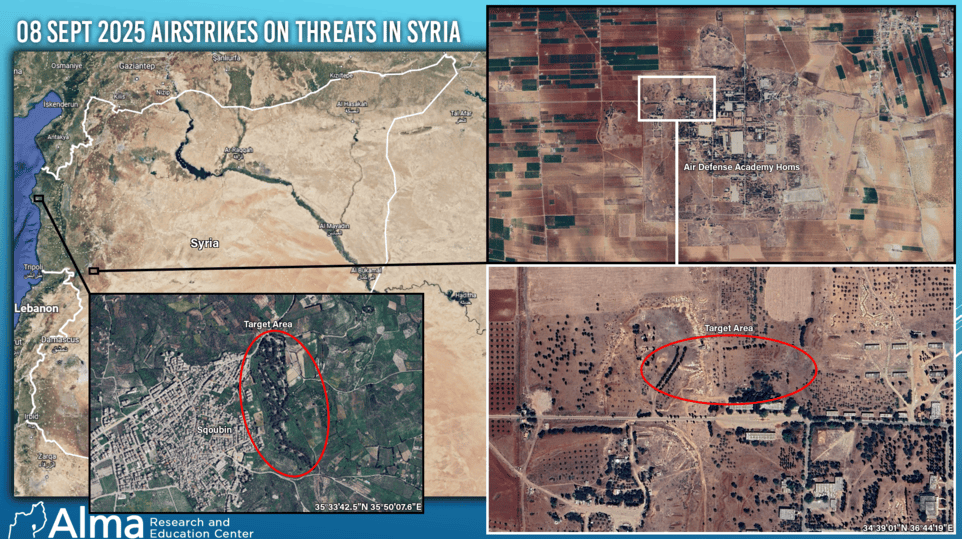
In August, it was reported that the IDF carried out a commando and aerial operation in al-Kiswah, near Damascus to dismantle Turkish espionage equipment. According to a report in the Syrian Al-Hadath, an Israeli official warned that al-Sharaa is “playing with fire” and “taking orders from Turkey.”
Moreover, it was reported in April of this year that Turkey planned to deploy its own air defense systems, of the HISAR-A and HISAR-O types, at the T-4 airbase in central Syria. These systems are considered significant and they pose a direct threat to UAVs, helicopters, and fighter jets like the F-16 and F-15 flying at low altitudes.
In the same month, a number of reports referred to Turkey’s intention to deploy the S-400 air defense system, which it purchased from Russia, at the T-4 base and other bases near Homs and Palmyra. Such a move could have provided a long-range defensive umbrella over central Syria and constitutes a strategic challenge.
Israel has made it clear that it will not tolerate Turkish bases near its border and has pledged to prevent Ankara from gaining a military foothold in Syria, partly due to concerns about the arming of Sunni jihadist elements in Syria. Turkish Foreign Minister, Hakan Fidan, tried to downplay the friction, but criticized the Israeli actions and warned that they endanger the region’s stability.
The Kurds in the Crosshairs?
The formal training of the Syrian army by Turkey establishes the strategic alignment between the Sunni al-Sharaa regime in Damascus and its main state supporter. This move is intended to strengthen the Syrian army also against the Kurdish Syrian Democratic Forces (SDF). The tension between the new Syrian army and the SDF, the US-backed Kurdish militia, is consistently high, despite a supposed agreement to integrate the SDF into the new regime’s forces. Local clashes between al-Sharaa regime forces and the SDF occur weekly.
Turkey’s Motives
Dr. Hay Eytan Cohen Yanarocak, a senior Turkey researcher at the Dayan Center at Tel Aviv University and the Jerusalem Institute for Strategy and Security, provided an analysis for the motives and courses of action of Turkey in the new Syria.
According to Yanarocak, since the fall of the Assad regime, Turkey has filled the vacuum created by the withdrawal of Russia and Iran, becoming an ally of the al-Sharaa regime and providing it with “all the infrastructure and logistics, and also helping them to a very large extent, so that they can integrate into the outside world diplomatically.”
However, the involvement does not stop at the diplomatic level. Turkey is interested in being present in Syria through “hard power”.
To achieve this, according to Yanarocak, Ankara wants to “basically turn the Syrian army into the long arm of Turkey in the region.” This intention is expressed through the training, which the Syrian army cannot refuse, since “the Turkish army operates according to the combat doctrine of NATO” and the Turks are even willing “to supply weapons, ammunition, and munitions, including their UAVs to Syria.”
Once the Syrian state stabilizes, Turkey will be able to turn Syria “into a permanent customer for the Turkish defense industry,” according to Yanarocak. Ankara sees Israel as “a threat against Turkey, despite the fact that we do not think we pose a threat,” said the Turkey expert.
Conclusion
The Turkish assistance to the building of the new Syrian army is not just logistical support, but a strategic move to establish a new regional alliance and a potential military threat:
- Formation of a new alliance: The building of the new Syrian state is being done with direct military and technical assistance from Turkey, which strengthens a new Sunni regional alliance hostile to the Iranian axis.
- Changing the air power balance: The attempt to transfer Turkish air defense systems (HISAR) and improved anti-aircraft systems are intended to make Israel reconsider its aerial freedom of action.
- A fragmented conflict map: Syria remains a battleground with multiple players. The ongoing conflict between the Turkish-backed al-Sharaa regime forces and the US-backed SDF, is a significant secondary front alongside the main struggle against the remnants of Iranian proxies.
- Challenging Israel’s policy: Alongside the collapse of Iranian influence, it is hard to escape the conclusion that there is a chance of a future clash between the new Syrian-Turkish Islamist axis and Israel. This is a real long-term risk that requires corresponding Israeli preparation. Has Israel begun to prepare for this? We are not sure.

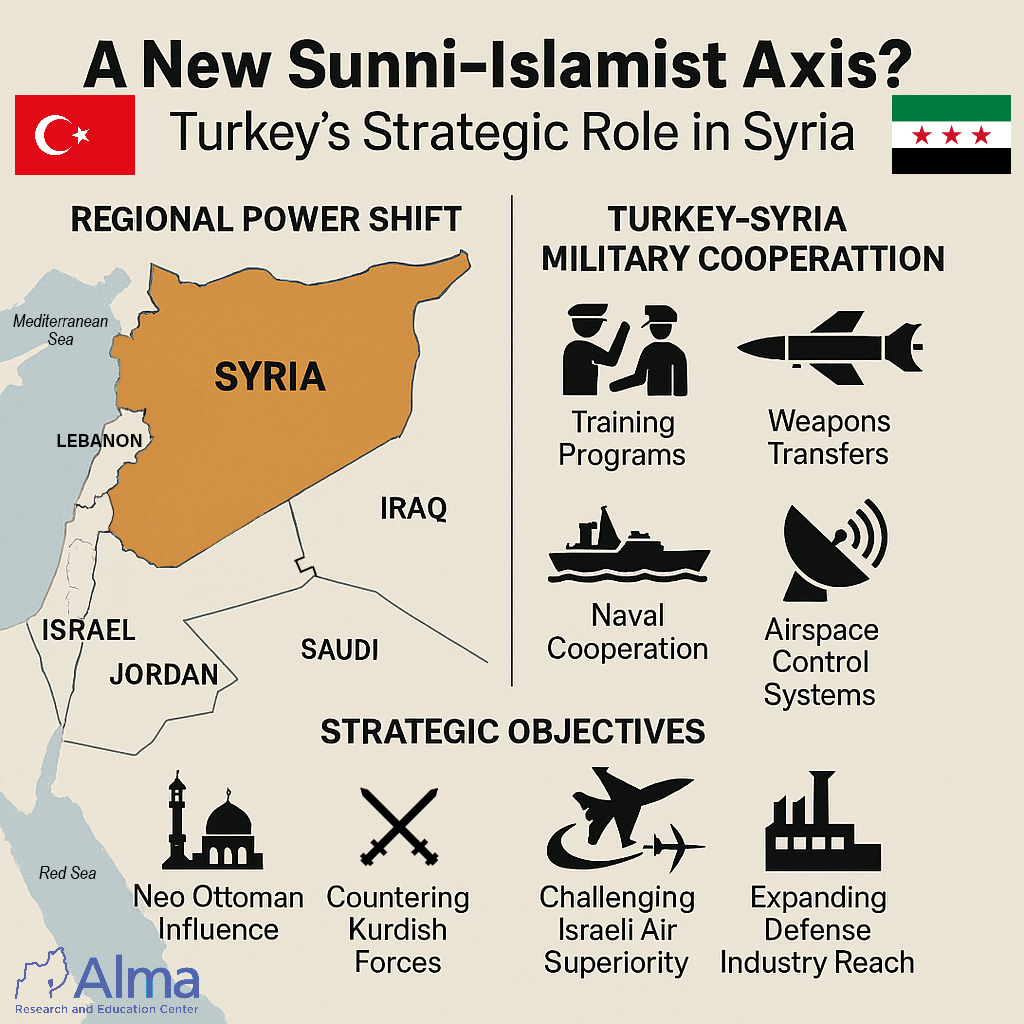

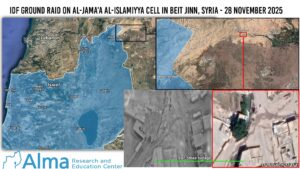
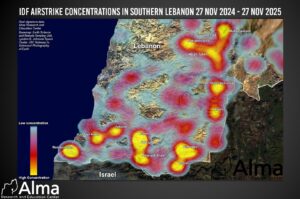
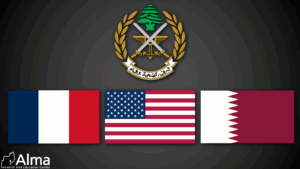

2 Responses
Having worked in Turkey many years ago and during the period when Erdogan was mayor of Istanbul, I recall his radical positions particularly visa vie Israel. That has not changed. He would like to regain the Sultan position of the Ottoman Empire and his comments about Jews and Israel being a “terrorist State ” reflects his true position; . saying Israel is the major threat in the region. I am sure he would love to place Turkish troops in Gaza and then support Hamas. I hope that Trump nor Bibi allow that. Vance said this morning that Israel would have the final say as to who comes into Gaza to help establish a government coalition that excludes Hamas; hopefully, that will be the case.. Enshallah.
Dear Yaakov,
We should tell it like it is: Erdogan is a muslim brotherhood radical islamist with intentions of restoring a caliphate empire. He is a Hamas supporter. Any Turkish presence in Gaza is like opening the door for another terror campaign against Israel. Qatar in Gaza would also lead to another disaster. These states cannot have ANY role in the security or enforcement of justice in Gaza. Both countries have proven records for supporting hamas terrorism. End of discussion.